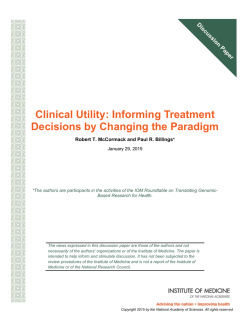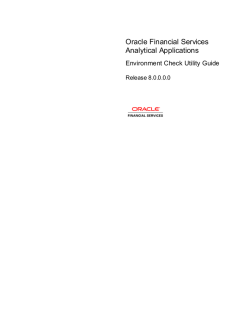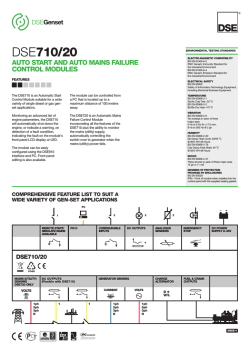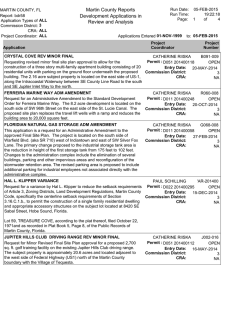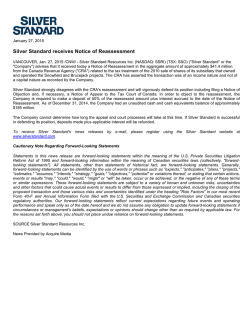
Download PDF - Charles River Associates
Clean power plan paranoia February 2015 By Robert Kaineg and Michael Neimeyer Articles Clean power plan paranoia 1 The distributed resource plan 3 Default service energy auctions in deregulated states 4 Order 1000: a boon to independent developers? Energy Practice Services Investment Strategy, Planning, and Prioritization Transactions / M&A Support Regulatory Strategy and Support Portfolio and Enterprise Risk Management Market Design and Restructuring Procurement and Competitive Bidding Expert Testimony and Support EU State Aid Analysis and Support 5 In June 2014, the Environmental Protection Agency (EPA) promulgated the Clean Power Plan (CPP), the first-ever proposal to regulate CO2 emissions from existing power plants under Section 111(d) of the Clean Air Act. The EPA proposed average CO2 emissions rate goals for each state by defining state-specific best systems of emissions reductions (BSERs) comprised of four “building blocks.” This proposal has been found to have critical limitations. Over the past several months, the EPA has fielded more than two million comments, many of which question the ability to achieve various state goals on the timeline and at the costs assumed for each building block. In addition, there has been much discussion around the rationale behind excluding certain CO2 abatement mechanisms from the four-block BSER framework. In a Notice of Data Availability released in October, the EPA acknowledged some of these concerns, and expressed openness towards significantly revising the initial proposed parameters of the CPP. Between now and summer 2015, when the EPA is due to release a final rule, decision makers in the utility and energy spheres face vast uncertainty surrounding the rule‟s timing and stringency. Moreover, in the following year (or two), public service commissions and interested stakeholders will wrangle over the details of each state‟s implementation plan, particularly around whether to form multi-state trading compacts (e.g., Regional Greenhouse Gas Initiative (RGGI)). In such an environment, resource planners and policymakers alike can greatly benefit from a set of modeling tools that (1) allow for formulation of scenarios that encompass a range of possible CPP futures and (2) can simulate impacts to both unit-level electric dispatch and broader macroeconomic indicators. CRA‟s National Electricity & Environment Model (NEEM) and the Multi-Region National Model (MRN-NEEM) are the culmination of over two decades of development, designed specifically to account for policies like the CPP. NEEM‟s logic and algorithms are similar to those in the Integrated Planning Model (IPM) used by the EPA in its initial CPP analyses, and complements the IPM and the Energy Information Administration„s (EIA) National Energy Modeling System (NEMS) as one of the nation‟s most comprehensive modeling frameworks for analysis of impacts of emissions regulations on the power sector. Further, in MRN-NEEM, CRA has developed a state-ofthe-art, computable general equilibrium, top-down model of the US macro-economy. MRN-NEEM offers the most realistic simulation of the ability of the economy to respond to the structural and cross-sector changes created by CO2 policies. Importantly, MRN-NEEM estimates natural gas and coal price responses to demand shifts, particularly in the electric sector. Throughout the past six months, CRA has been using NEEM and MRN-NEEM to investigate variations of the proposed CPP on behalf of our clients. Table 1 shows the key questions CRA has helped our clients answer. Sorting through these kinds of questions will be pivotal for those hoping to shape the direction of CPP policy and for those utility decision makers looking to develop a robust business plan in whatever CPP future materializes. Arriving at the right answers requires a thoughtful approach grounded in a sound understanding of how the power sector and broader economy might transform under different CPP scenarios. Table 1: Key CPP questions and approach Questions CRA approach Impose a retrofit or retire decision on each coal-fired electricity generating unit, so that the model decides whether the heat rate Can a 6% heat rate improvement at $100/kW improvement makes economic sense in the presence of CPP CO2 emissions rate limits be achieved for all US coal? What are the alternatives? Vary the assumed heat rate improvement and costs to assess how compliance pathways change in scenarios where the heat rate improvements do not materialize at the scale assumed by the EPA Are EPA’s assumed renewable and demand-side energy efficiency (DSEE) o penetrations achievable? Are EPA’s DSEE costs reasonable? o Assess the impacts on a utility‟s coal-fired assets, and identify units vulnerable to reduced dispatch and/or retirement Will new natural gas-fired combined cycle plants be built to replace retired coal capacity, and how will this affect natural gas prices? Quantify any decline in total electric system costs by state What are the benefits of my state establishing a multi-state cap-and-trade market with surrounding states? If adding carbon capture and storage (CCS) retrofits were viable compliance mechanisms, how less stringent would the CPP goals be? Examine worst-case scenarios in which renewables and/or DSEE penetrate at some small percentage of EPA‟s assumed ramp rates Determine how the generation mix in individual states and across multi-state compacts changes as the result of regional compliance Assess whether CCS retrofits come online under varying technical assumptions for retrofit costs/penalties, CO2 storage and transport, and magnitude of enhanced oil recovery revenues o Will coal prices at particular basins change significantly due to the penetration of CCS? CRA Insights: Energy | 2 The distributed resource plan By Jim McMahon The growth of distributed resources as a legitimate, albeit early stage alternative to central station power has forced many utilities to reconsider their integrated resource planning (IRP) practices. In recent years, the costs of solar photovoltaic (PV) panels have rapidly decreased, while the incentives and rebates for their installation have increased. This led to a significant increase in solar PV installations, particularly in states with favorable rate treatment (e.g., net metering). Many utilities have been asking how they should incorporate the growth of distributed resources in their IRP process. Traditionally, IRP was intended to produce a long-term resource investment plan for the utility to effectively match supply to demand. When customer demand grew steadily, the IRP often determined the optimal type and size plant to meet incremental and system-wide need. It also provided the important justification to the regulator that these large capital investments were prudent. In the future, distributed energy resources may serve to meet at least a portion of incremental load growth. While central station resources are not likely to go away, they will need to be planned in concert with distributed power. Some utilities are taking steps to integrate distributed and centralized resource planning. CRA recently worked with a large utility that is considering replacing a coal unit, expected to retire in the next three years, with a new natural gas plant. This utility is located in a state with relatively aggressive solar policies. For the first time, the utility‟s IRP will consider how the growth of distributed resources will displace power that would otherwise have been served by the utility‟s proposed plant. On the flip side, the utility is emphasizing the need for a strategically located natural gas unit and transmission and distribution (T&D) upgrades to help balance the grid as more solar is deployed. Increasingly, we expect utilities to ask themselves complex questions that will require more rigorous and comprehensive analysis than ever before. For instance: What is the impact of distributed generation (DG) on the need for utility-scale generation? Does penetration of PV mean reduced need for peaking resources (assuming a summer peaking utility) or does it simply reduce consumption? What does this mean for their returns? How should the utility think about rates under a growing DG scenario? Is the balance between fixed and variable components consistent with the expectation for reduced MWh, but increasing need for “back up?” What role should utilities play in the deployment of DG (do they react to customer-driven trends or do they push particular technologies/programs)? Utilities should consider revamping their integrated resource planning and overall business planning practices to account for the distributed resource reality. While many utilities have developed Boardroom views on the utility of the future, we have infrequently seen that translate to operational strategy. Three things a utility can do immediately to address the issue: (1) bring resource and system planners together for a facilitated session on the future of the utility; (2) develop a set of scenarios for distributed generation growth and model the impact on the utility‟s resource portfolio; and (3) assign responsibility for integrated planning to a single individual who can ensure consistency and robustness of plan. CRA Insights: Energy | 3 Default service energy auctions in deregulated states By Robert Lee Retail competition for electric supply fundamentally alters the role of the electric utility in its franchise service territory. Prior to retail competition, vertically integrated utilities were responsible for the three phases of delivering power to customers: generation, transmission, and distribution. During the era of the vertically integrated utility, the monopoly provider constructed and operated generating stations on behalf of customers and passed all prudently incurred costs through to utility customers under cost-of-service rate models. The utility was responsible for analysis, planning, and investment decisions based on the outlook for customer load growth, pending environmental regulations, changes in fossil fuel prices, and changes in technology. Customers either benefited from their foresight or lived with the consequences of their mistakes through the generation cost embedded in customer rates. The Energy Policy Act of 1992 created a framework for retail competition and many states initiated the process of introducing competitive suppliers to the market. Retail choice freed customers to choose their electricity supplier and forced utilities to compete on a (somewhat) level playing field with other providers in the market. Competition for generation service did, however, leave the utility with a unique role in the marketplace. The utility retains responsibility for transmission, distribution, and customer metering and serves as the generation provider of last resort (POLR) for the market. This POLR obligation is a safeguard for customers, ensuring that all consumers ultimately would have access to reasonably priced electricity. However, without a stable count of customers and a predictable level of customer load, the traditional cost-of-service rate model is increasingly untenable. Amortizing fixed investment in generation across a smaller and highly variable set of customers inevitably leads to significant increases in default service rates. Higher default service rates, in turn, inevitably lead to a death spiral for the utility — greater customer migration and even higher rates. CRA‟s Auctions & Competitive Bidding Practice conducts online auctions for the FirstEnergy Ohio utilities, Duke Energy Ohio, the Dayton Power & Light Company, and the FirstEnergy Pennsylvania utilities. Through these auctions CRA procures energy, capacity, and ancillary services to support that POLR obligation. Participants, who range from independent power producers, cooperatives, and utilities to financial institutions and energy traders, bid on standardized supply contracts each representing a fixed share of the needs of each utility‟s default service customers. Bidders agree to a fixed price per MWh for all MWh of load regardless of what that load turns out to be. The percentage of load commitment by winning bidders, who then become the default suppliers, allows the utilities to transfer quantity risk from the utility to the supplier. The fixed bidding price aspect of these auctions enables the utility to offer a stable rate to customers in a marketplace where rate stability is a unique offering that competitive suppliers have difficulty matching. The results of CRA‟s default service procurements have been embraced by the utility commissions in both Ohio and Pennsylvania. The cost of electricity for ratepayers in those markets has declined considerably since the competitive procurement processes were introduced. After Duke Energy Ohio‟s initial auction in December of 2011, the company was able to reduce the generation portion of consumer rates by 30% and overall default service customer utility bills by more than 17%. These reductions will benefit both the utility and consumers as the auctions maintain stable electricity prices over the near term. CRA Insights: Energy | 4 Order 1000: a boon to independent developers? By Jim McMahon and Ryan Fox Has Order 1000 opened the floodgates to competition in electric transmission? Should we expect to see new transmission projects regularly awarded to non-incumbents? The answer is that it depends on the type and location of the project and on the incumbent utility. FERC‟s Order 1000 requires regional transmission planning organizations to develop a “not unduly discriminatory regional process for transmission project submission, evaluation, and selection.” In most parts of the US, this has led to a multi-stage, independent review process. Once the necessity of a project has been established, the regional planning organization will review the project across a number of criteria. These criteria generally boil down to the company‟s financial and operational capabilities, the effectiveness of the proposed solution, and the project cost. Most utilities and the largest merchant players will pass the capability screen and often will offer relatively similar technical solutions. That may leave cost as the primary determinant for an award. The three major components of a transmission‟s project cost are: construction, capital, and operations and maintenance (O&M). All three of these costs can differ significantly between project proponents, particularly when comparing an independent developer with an incumbent utility. An independent developer may have the benefit of experience in having completed similar projects, which often translates to a lower construction cost. When compared to a smaller utility, this may impart a significant advantage. An independent also may have a lower cost of debt relative to a utility, depending upon the size of the parent organization, its debt rating, and its access to the capital markets. An incumbent utility, on the other hand, may have the benefit of lower O&M costs in servicing the project, particularly if it already services nearby transmission assets. Consider a large substation project to be located in a utility‟s service territory, near other major electric infrastructure. Two companies are bidding on the project: an independent developer and the incumbent electric utility, which happens to be a subsidiary of a large utility holding company. In this case, the two bidders may show only small differences in estimated construction and capital costs as both have significant scale and experience with similar projects. On the other hand, the utility may have a significant O&M cost advantage over the independent if it can maintain the infrastructure with minimal incremental costs given the proximity of the asset to infrastructure already maintained. Now consider a 50-mile, 345kV transmission project and two potential developers: the same large independent developer and a small incumbent utility. Here, the cost calculus may be much different than in the substation example. First, the independent may have a significant construction and capital cost advantage from experience with similar projects and access to the capital markets. Second, the utility may not have a significant O&M cost advantage if it involves maintaining lines that are not proximate to existing assets. In this case, the independent may have the cost advantage. While Order 1000 will not completely turn the tables on incumbent utilities, for certain projects and in certain jurisdictions, there are real threats. Utilities can take the following steps to protect their turf: 1. Identify ways to create an O&M cost advantage: often utilities can allocate existing resources strategically to serve new projects cost effectively. This compares to an independent that likely will need to outsource O&M at a relatively higher cost. 2. Understand the independent developer: how is their cost of capital different? That should be knowable. Also, what type of advantage do they have in design/build from a labor and materials perspective? CRA Insights: Energy | 5 3. Consider risk reduction methods: one way to improve a bid is to include cost caps or related cost controls. A utility may have greater confidence in its ability to control construction or O&M costs than an independent, based on knowledge of the terrain and its workforce. Consultant profile David Hunger, Vice President, PhD David is a Vice President in CRA‟s Energy Practice, focusing mostly on FERC matters. A former senior economist at the Federal Energy Regulatory Commission, he is an expert in energy market merger analysis and market rate matters. For more than 10 years at FERC, David led analyses involving mergers and other corporate transactions; market power in market-based rates cases; investigations of market manipulation in electricity and natural gas markets, demand response compensation, compliance cases for regional transmission organizations; and competition issues in electricity markets. Since 2001, David has been an affiliated professor at the Georgetown Public Policy Institute (GPPI) where he teaches microeconomic theory, energy policy, and public finance. About CRA’s Energy Practice CRA‟s Energy Practice provides strategic, financial, and consulting services to a wide range of energy industry clients. With years of industry experience and exceptional strength in analytics, our consultants offer management, regulatory, and economic expertise to all sectors of the power and gas markets—as well as hands-on experience helping clients manage market power, environmental policy, and regulatory issues. We have pioneered techniques and models that have become industry standards, including competitive market designs, efficient bidding mechanisms, creative financial transactions, and methodologies to assess market power. The Energy Practice has offices in Boston, Washington, DC, Houston, and London. Learn more at www.crai.com/energy. Contributors Jim McMahon, Vice President, +1-617-425-6405, [email protected] Robert Lee, Vice President, +1-617-425-3365, [email protected] Robert Kaineg, Senior Associate, +1-202-662-3931, [email protected] Michael Neimeyer, Consulting Associate, +1-202-662-7881, [email protected] Ryan Fox, Consulting Associate, +1-617-425-6571, [email protected] The conclusions set forth herein are based on independent research and publicly available material. The views expressed herein do not purport to reflect or represent the views of Charles River Associates or any of the organizations with which the authors are affiliated. The authors and Charles River Associates accept no duty of care or liability of any kind whatsoever to any party, and no responsibility for damages, if any, suffered by any party as a result of decisions made, or not made, or actions taken, or not taken, based on this paper. If you have questions or require further information regarding this issue of CRA Insights: Energy, please contact the contributor or editor at Charles River Associates. This material may be considered advertising. Detailed information about Charles River Associates, a registered trade name of CRA International, Inc., is available at www.crai.com. Copyright 2015 Charles River Associates CRA Insights: Energy | 6
© Copyright 2026

